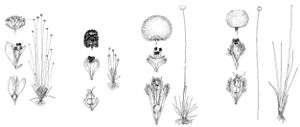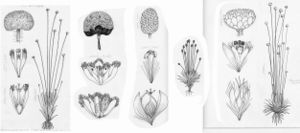Eriocaulaceae
Herbs, annual or perennial, cespitose or solitary, rosulate, rarely caulescent, mostly scapose, glabrous or variously pubescent with simple or compound hairs. Rootstocks rhizomes or stems, thickened, short to variously elongate; roots fibrous, spongy, or spongy-septate (diaphragmatic). Stems erect to repent or prostrate, axis sympodial or monopodial, sometimes branching. Leaves mostly many ranked in rosettes, sometimes in loose spirals, mostly grasslike; blade linear to linear-triangular, lingulate, tapering, base mostly clasping; veins parallel. Inflorescences terminal and/or axillary, simple [compound], involucrate [proliferative], buttonlike or short-cylindric; scape sheaths spathelike, tubular, enclosing scape base, distally open; scapes 1–many, simple [compound], terete, usually twisted, mostly multiribbed; involucral bracts spirally imbricate series, usually chaffy or scarious, grading inward to receptacular bracts or these absent; receptacle glabrous or variously hairy. Flowers (florets) unisexual, staminate and pistillate on same [rarely different] plants, radially or bilaterally symmetric; sepals 2–3, distinct or variously connate, diverging from stipelike base or merely part of lobeless column; petals 0 or 2–3, diverging from short to elongate stipe (part of androphore or gynophore) or merely part of lobeless column; stamens 2–4(–6), often unequal; filaments arising from floral axis, rarely epipetalous; anthers mostly black, 1–2-locular, 2–4-sporangiate, versatile or basifixed, dehiscence longitudinal; pollen 1-grooved, 3-nucleate; appendages present in some flowers, glandlike or peglike, rarely bladelike, sometimes fringed or variously cleft; pistil compound, 2–3-carpellate; ovary superior, raised on gynophore, 1 locule per carpel; ovules 1 per locule, adaxial-apical, pendulous, orthotropous, bitegmic; style terminal, appendaged or unappendaged, 2–3-branched, branches simple or apex rebranched. Fruits capsules, thin-walled, loculicidal. Seeds translucent, ovoid, ellipsoid, or broadly fusiform, mostly 1 mm or shorter, variously ribbed or sculptured; endosperm copious, mealy-starchy, with compound starch grains; embryo apical.
Distribution
Nearly worldwide, primarily tropical and subtropical regions.
Discussion
Most Eriocaulaceae grow in full sun in acidic wet soils or in aquatic situations.
Genera ca. 13, species 1200+ (3 genera, 16 species in the flora).
Selected References
Lower Taxa
Illustrations
Key
| 1 | Lacunar tissue evident at leaf base; larger roots pale, thickened, septate, unbranched; perianth parts in 2s (except in Eriocaulon cinereum and E. microcephalum), petals with glands on adaxial surface; stamens 3–4 or 6; anthers 2-locular, apex of staminal column with 2–3 glands, glands unappendaged; pistil 2(–3)-carpellate; style unappendaged, 2(–3)-branched | Eriocaulon |
| 1 | Lacunar tissue not evident at leaf base; larger roots either dark, fibrous, and evidently branched or pale, thickened, and spongy, neither septate nor branched; perianth parts in 3s (except in Lachnocaulon digynum), petals if present without glands; stamens (2–)3; anthers 1–2-locular; apex of staminal column usually with 3 glands, glands appendaged or unappendaged; pistil (2–)3-carpellate; style appendaged, 2–3-branched. | > 2 |
| 2 | Roots dark, slender, fibrous, evidently branched; scapes glabrous or hairy, hairs neither swollen nor glandular; expanded inflorescences ovoid to globose or short-cylindric, basal involucral bracts reflexed, obscured by inflorescence; hairs of perianth club-shaped; staminal filaments adnate to rim of androphore; anthers 1-locular; style branches 2-cleft | Lachnocaulon |
| 2 | Roots pale, thickened, spongy, appearing unbranched; scapes hairy, at least some hairs swollen basally, often glandular distally; expanded inflorescences hemispheric to globose, basal bracts not obscured by inflorescence; hairs of perianth tapering, acute, not club-shaped; staminal filaments low in corolla tube; anthers 2-locular; style branches undivided | Syngonanthus |

